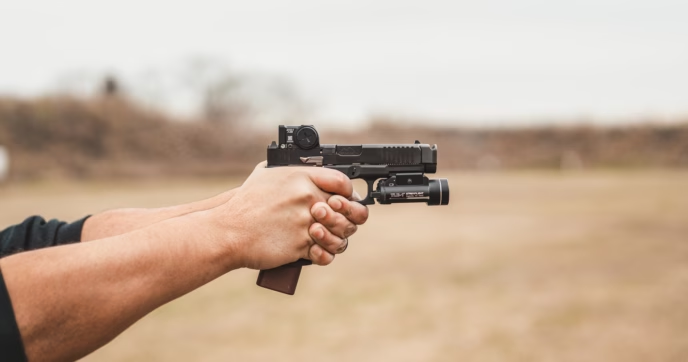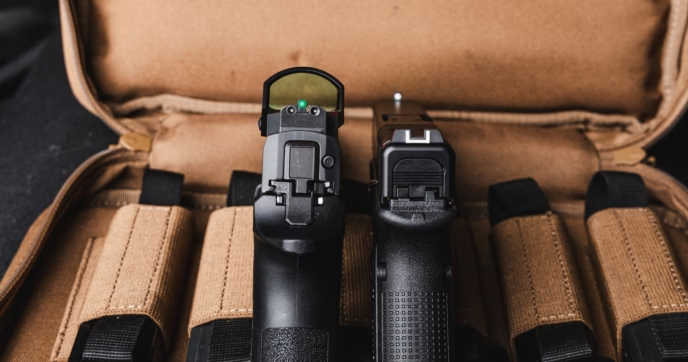3-Gun competition is one of the more gear-intensive shooting sports out there. While you can get started in IDPA or USPSA with nothing but a handgun, a holster, and a few spare mags, 3-Gun is a different beast. You’ll need, at minimum, three separate firearms (hence the name), a holster for your handgun, a variety of magazines and pouches, chamber flags, and more. To be truly competitive in the discipline, the list gets even longer.
Here, though, we’d like to take a look at just one piece of 3-Gun equipment, and the most important one of all: your rifle.
Basics of 3-Gun Competition
To understand what makes a good 3-Gun rifle, you’ll need a basic understanding of the competition itself. 3-Gun, as well as similar disciplines such as Multigun and 2-Gun competitions, are a form of competitive shooting that involves using multiple firearms to engage targets in a time-restricted fashion.
Like USPSA and IDPA, 3-Gun utilizes a time-based scoring system. Each stage is timed, with misses or sub-par hits adding time to your score. After these hit-based seconds are added, the competitor with the lowest time is the victor.
Unlike pistol-based sports, 3-Gun stages may be completed with a pistol, rifle, and shotgun, either individually or in any combination thereof.
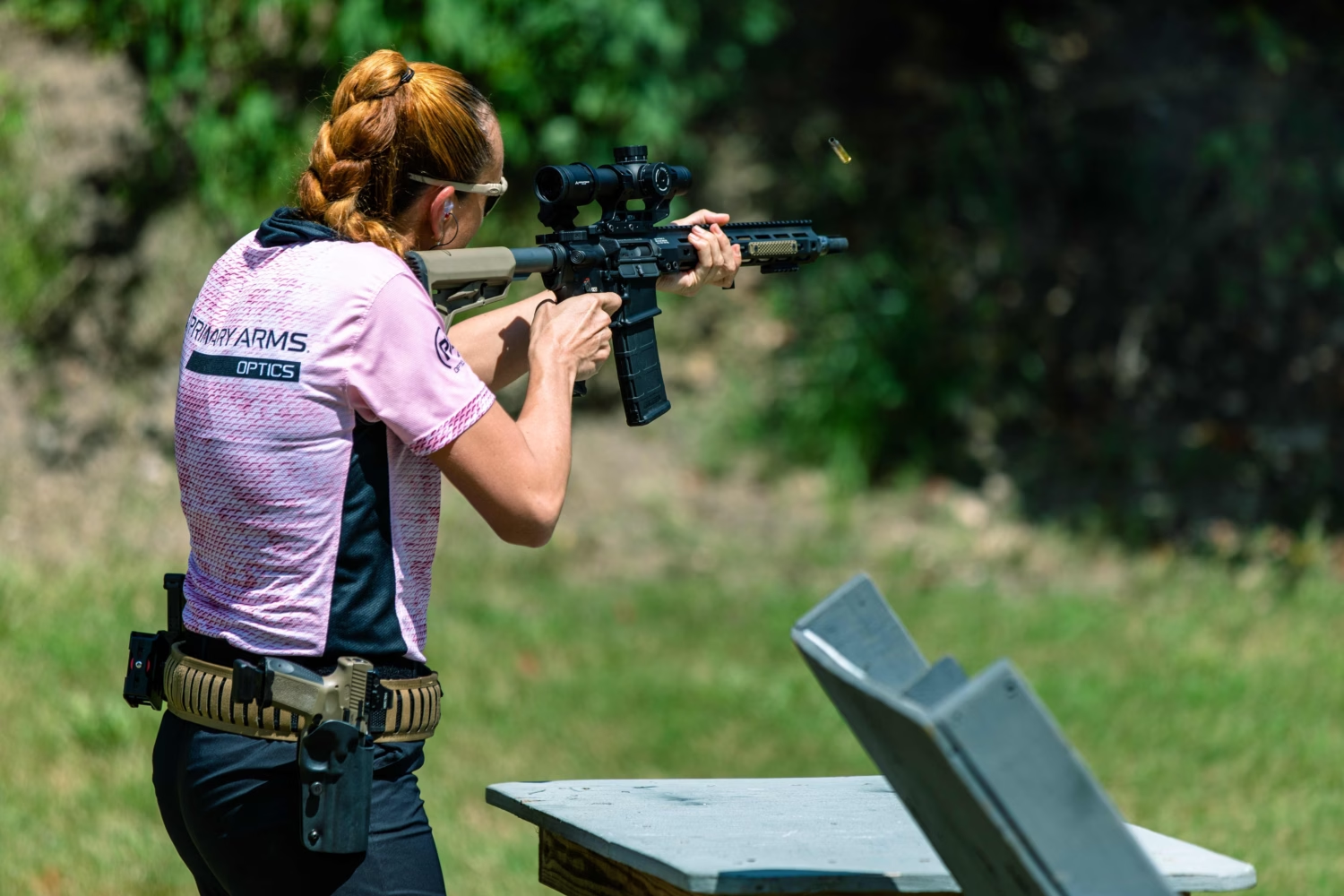
Considerations for 3-Gun Competition
Because speed is imperative in this discipline, you’ll want all of your firearms to be capable of delivering accurate fire as rapidly as possible. Many targets will require multiple hits to eliminate. Typically, standard cardboard targets will require two hits, while falling steel will often only need one. More hits may be specified by the stage instructions.
3-Gun also requires a fair bit of movement—it is an action sport, after all—so you’ll want to avoid anything that unnecessarily weighs your firearm down. The more your guns weigh, the slower you’ll be, both in moving around the stage and in transitioning between targets. While this can be mitigated with training, no matter how fast you get with your 10-pound rifle, you’d be faster with one that weighed only 7 pounds, all else being equal.
Reliability is, of course, always a priority. Clearing in a malfunction in the middle of a stage is hardly going to be beneficial to your time. However, since this isn’t a defensive firearm, it’s worth maintaining the perspective that a malfunction isn’t life or death. If you can’t afford a flawlessly reliable setup, it’s perfectly fine to make do with what you have or can afford while you learn the ropes and upgrade later. If you’re competing for fun or to keep your skills sharp rather than trying to take home national trophies, a rare malfunction here or there isn’t going to make that much difference.
3-Gun rifles, in particular, also need to be versatile. This is less true for handguns and shotguns, as those are more specialized tools that will only be called upon to engage targets within their effective ranges. You’d be hard-pressed to find a pistol with which a reasonably skilled user couldn’t hit the targets in a typical 3-Gun stage.
Rifles, on the other hand, need to be able to engage targets at nearly any distance. 3-Gun does not prescribe a specific maximum distance for targets during a rifle stage, so you’ll want to be as prepared as possible. While your MK18 clone might be ideal for more CQB-inspired stages, if the match director throws a 600-yard target into the mix, you’ll quickly find yourself wishing for something with a less parabolic drop profile.
With that said, most targets in a 3-Gun competition will usually be on the shorter end of the spectrum, so don’t grab your 26″ varmint rifle either.
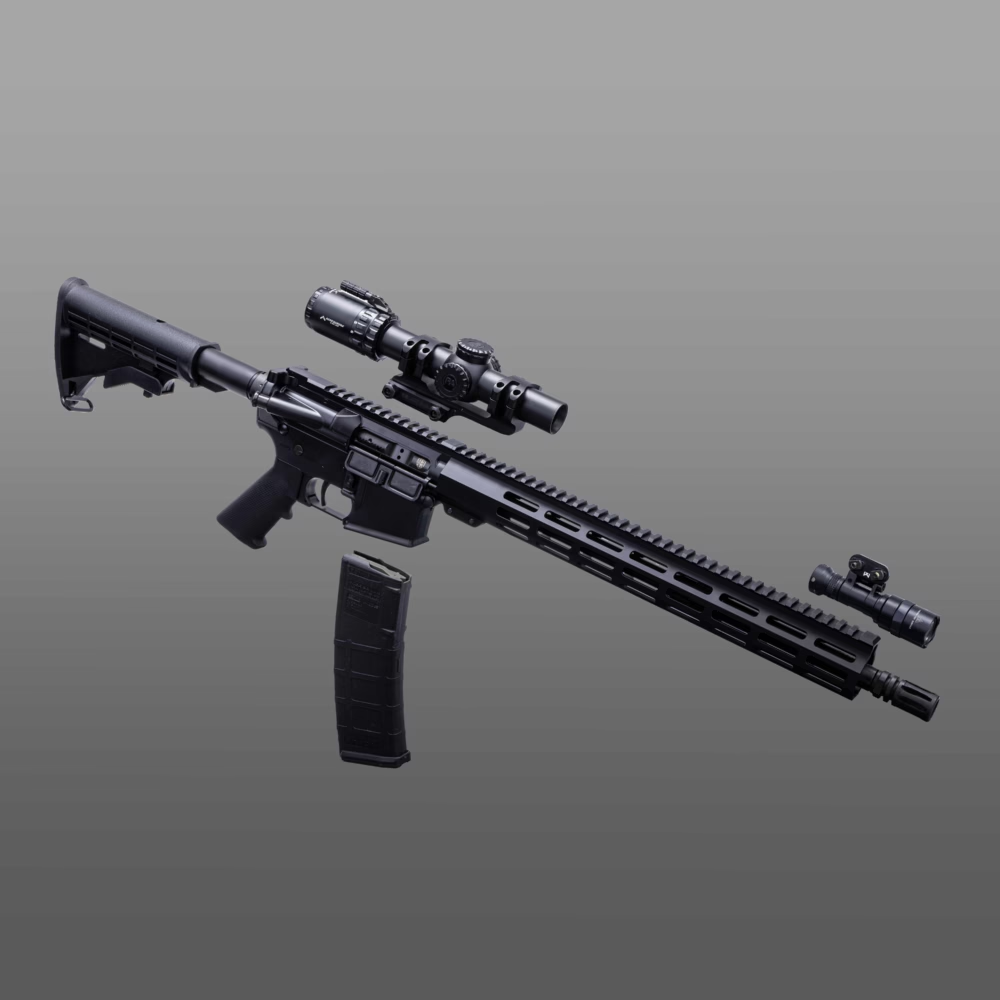
Customizing Your 3-Gun AR-15
While an AR-15 isn’t technically required for 3-Gun, there’s a reason it’s the overwhelmingly most common choice. Competitors can run any semi-automatic rifle chambered in .223 or a larger round, but AR-15s tend to be the cheapest and easiest to optimize for the sport by far.
To set up your AR-15 for success, you’ll want to pay particular attention to the following attributes.
Barrel Length
The length of your barrel has a direct effect on your velocity, and your velocity will heavily influence your ability to hit targets at extended ranges. At the same time, your barrel length will also play a huge role in the weight and balance of your rifle. Too short, and you’ll struggle to hit targets beyond a few hundred yards; too long, and your rifle will be cumbersome to work around barricades and slow to swing between targets.
The happy medium tends to be between 13.7 and 18 inches. 13.7″ is generally as short as you can go and still make it to 16″ of overall barrel length with a pinned and welded muzzle device. This is important because official 3-Gun rules do not allow the use of AR pistols in place of a rifle. Even most unofficial matches will usually prohibit braced pistols.
While SBRs are typically permitted, due to the restrictions around interstate transport, they are an inconvenient option if you want to compete at a national level. Moreover, barrel lengths shorter than 13.7″ tend to struggle at extended ranges on account of the reduced velocity. For that reason, a 13.7″ or 14.5″ barrel pinned and welded to 16″ is the shortest configuration recommended to most competitors, unless you have a compelling reason to go the SBR route.
This is, of course, dependent on your individual circumstances. If you compete solely in your local league and have no plans for interstate travel, an SBR may be a compelling option, particularly if your range is limited to a maximum distance of just a couple hundred yards—as many ranges are. In that circumstance, a shorter barrel would offer little handicap and may be advantageous for shorter stages.
On the other end of the spectrum, we generally don’t recommend exceeding 18″ for a competition rifle. Even a rifle with an 18″ barrel can be a chore to maneuver around a tight stage, and any gains made in velocity beyond that point are marginal at best for this application.
Trigger
Your trigger is the primary mechanism by which you interface with your rifle. It’s a crucial element, one you will be engaging with every single shot you fire. 3-Gun is a precise sport; every shot you pull will mean seconds added to your time, so it’s important to choose a trigger that works with you, not against you.
This typically means you’ll want a trigger with a short travel and relatively lightweight pull. The shorter the travel, the faster you can fire and the less chance you’ll have to flinch or shift and throw your shot off target. Lighter pull weights similarly tend to be easier for most users to actuate without accidentally tensing their hand or arm and affecting the rifle.
The exact make and model of your trigger is largely a matter of personal preference. Geissele, Triggertech, CMC, Hiperfire, and more all make suitable triggers for 3-Gun competition.
Generally, most users are best served by a single-stage trigger for this type of fast target engagement, but a two-stage trigger can certainly be used to great effect, particularly by those well-accustomed to them.
Muzzle Device
Minimizing recoil is a big part of customizing your rifle for 3-Gun. The less recoil your rifle has, the easier it will be for you to control the muzzle rise and get your gun back on target for follow-up shots. Since most targets will take two hits to eliminate, follow-up shots will be quite common, so your ability to get back on target after firing is paramount.
Weight will arguably play the largest role in the amount of felt recoil your rifle produces, but your muzzle device will often be the second most important factor. A good muzzle device can substantially blunt recoil and keep your rifle stable, even during rapid-fire strings.
Muzzle brakes tend to be the most effective for this. While we are generally partial to suppressors as the muzzle device of choice for most applications, when you need the absolute maximum recoil reduction, there’s really no competing with a quality brake.
If your rifle is dedicated solely for the 3-Gun use, then feel free to grab the largest, most effective brake allowed by your league. If, on the other hand, you plan on using one rifle for a multitude of different purposes, we recommend a QD muzzle brake.
QD brakes combine the porting of a traditional muzzle brake with a section of external threading that allows for the attachment of a suppressor over the brake. This allows users the best of both worlds; without a suppressor installed, you’ll be able to take advantage of the recoil-reducing properties of the brake, which often come close to rivaling that of dedicated brakes. Then, for training, plinking, or other purposes, you can thread a suppressor over the brake to save your hearing.
Lightweight Parts
Weight is a perpetual balancing act for a 3-Gun rifle. A heavier rifle will have less felt recoil, but will also be more fatiguing to manipulate during longer stages and slower to swing between targets. A lighter rifle is the inverse, but felt recoil can often be mitigated by other methods, such as tuning the gas system and installing the aforementioned muzzle brake.
As such, 3-Gun rifles trend towards lighter rather than heavier. There are a lot of ways you can trim weight from your rifle using specialized lightweight AR-15 parts. Ultralight furniture is one of the simplest and has the fewest drawbacks. By opting for a carbon fiber handguard and simple, spartan AR-15 grip and stock, you can pretty easily shave a few ounces off your rifle with essentially no trade-offs other than the money spent.
AR-15 accessories such as foregrips, bipods, flashlights, and the like should be kept to a minimum. Certain stages or competitions may prohibit the use of bipods entirely, while flashlights will almost never be needed in a competitive context and are essentially dead weight.
A lightweight barrel, on the other hand, can take a pound or more off your gun’s weight, but at the cost of less rigidity. Less rigid barrels can be less accurate during rapid fire due to the increased “whip” of the barrel, but often the accuracy loss isn’t enough to be noticeable at ranges where rapid fire is practical. At longer ranges, you’ll typically need more time to require your sights and stabilize your rifle between shots anyway, so the drawback is often minimal.
Other lightweight components such as titanium bolt carrier groups come at the cost of shorter service life. Lightweight bolt carrier groups also usually require significant tuning of the gas system to run reliably, so you may also need to replace your buffer, recoil spring, or gas block to install one successfully.
Lastly, if you’re building a rifle from the ground up, it’s worth considering an ultralight receiver set. Like barrels, ultralight receivers tend to be less rigid than their heavier counterparts but are often well worth the trade-off for a dedicated competition gun.
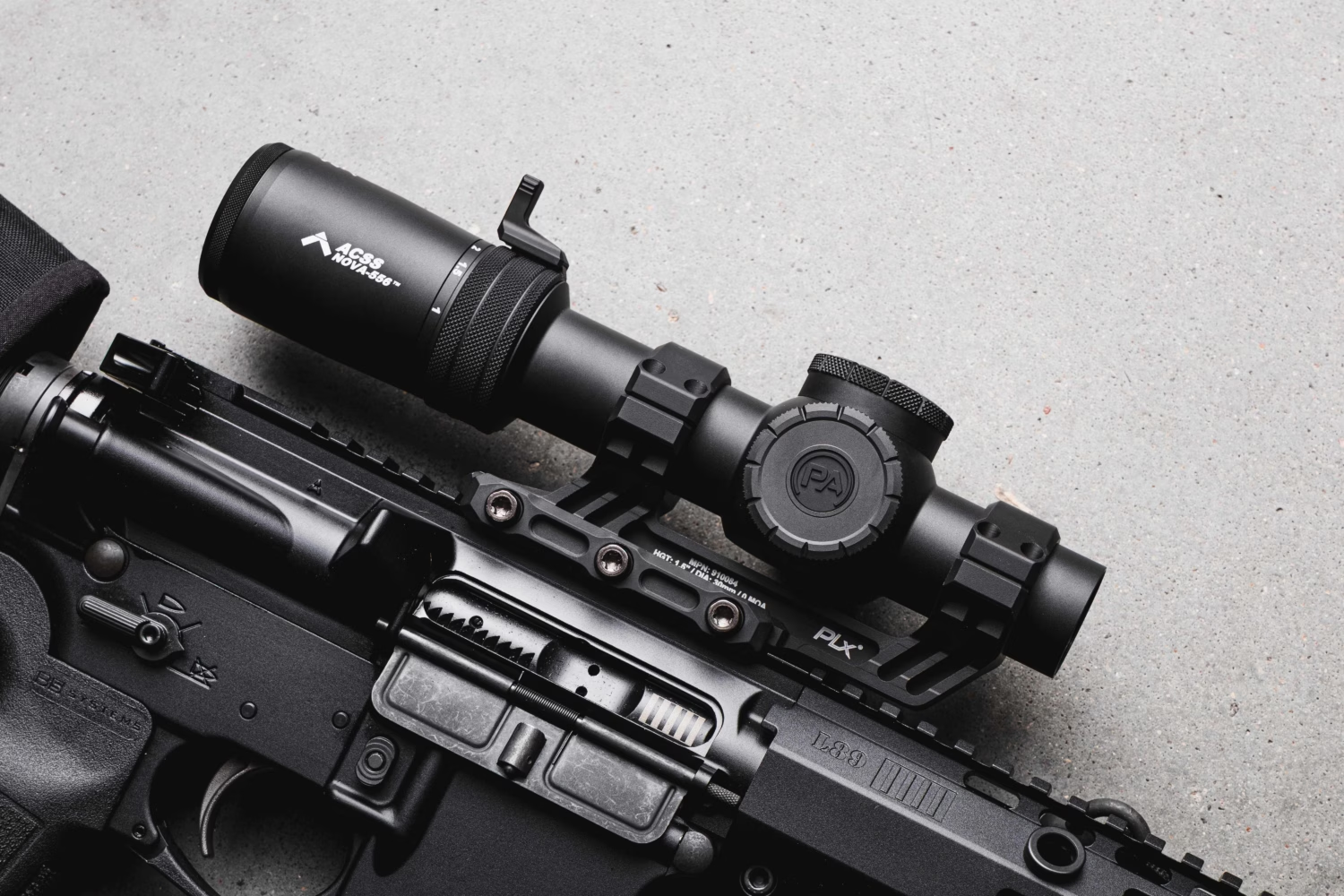
Best Optics For 3-Gun
Optics for a 3-Gun rifle are a much more divisive and complex topic than the aforementioned categories. The best optic or optics for your 3-Gun rifle will depend heavily on your circumstances and the division in which you intend to compete.
Like many shooting sports, 3-Gun separates competitors into different groups based on the equipment they will use. These groups are called divisions. Each division comes with it’s own rules, limiting what gear can be used.
You can think of divisions kind of like weight classes in combat sports. You wouldn’t put a 115-lb boxer up against a 225-lb heavyweight—regardless of skill, the larger fighter would almost certainly take the victory. In the same way, a competitor running irons sights really can’t be meaningfully compared against one with an LPVO and offset red dot sight. The advantage offered by the optics is simply too great to draw any meaningful conclusions about the two marksmen’s abilities.
Divisions help keep things even. The exact nature of the divisions can vary depending on what league you are competing in, but most are fairly analogous to the USPSA Multigun divisions, of which we will look at 3: Tactical, Limited, and Open. There are also Heavy Metal versions of each of these, which focus on larger, more powerful cartridges, but the optic considerations for those divisions are unchanged.
Of the three, Limited Division is the most restrictive when it comes to rifle optics, allowing only one optic which cannot be magnified. This limits optic options considerably, with most competitors opting for a simple, full-size red dot, such as a Primary Arms MD-21 or MD-25.
However, an alternative option is a 1x prism, which offers certain advantages over a red dot. The most notable would be the more sophisticated reticles prisms can accommodate, which can offer both ballistic drop compensation and ranging tools—a significant boon on targets at extended distances. While prisms cannot match the unlimited eye relief and massive eye box of red dots, modern prisms like the Primary Arms GLx 1x Microprism are exceptionally forgiving in both respects, and for practiced users, often just as fast as a red dot.
Tactical Division also limits users to a single optic but does not restrict magnification. Because of this, the vast majority of Tactical competitors opt for an LPVO. A 1-6x or 1-8x optic allows users to dial their magnification down to near zero for short-range work while still being fully capable of effective hits at extended ranges. While they may take a second or two to adjust between settings, the added time is usually minimal, since stages rarely shift from short- to long-range targets and back again more than once or twice.
Because an LPVO will be the sole optic employed at all ranges in Tactical division, it’s essential to select one that is highly functional at short range. A good example is the Primary Arms RDB and NOVA versions of the PlxC 1-8x. Each optic employs a different specialized technology to produce an extremely bright reticle illumination, drawing the eye and Fallowing for faster target acquisition at 1x magnification. The forgiving eye box and prodigious field of view further benefit their performance at short range without sacrificing long-range capability.
Open Division is the most permissive, with no restrictions on the number or magnification level of optics. In Open division, you will nearly always see competitors utilizing both a scope and a red dot.
The scope will often vary depending on the expected format of the match stages. LPVOs tend to be the most common, but for a match in open country with plenty of access to long sight lines competitors may opt for a medium power optic such as a 2-10x or 3-15x scope.
In either scenario, competitors will typically opt for an offset or piggybacked red dot sight. This allows them the advantages of both a magnified optic and a red dot with minimal drawbacks. Micro or mini reflex sights are often used to minimize additional weight, so the difference between an LPVO and an LPVO with an offset dot is typically only a few ounces. Transitioning between sights can take only a fraction of a second for a well-practiced user.
Both open and enclosed reflex optics can be used, depending primarily on user preference. Enclosed optics are more resistant to intrusion by foreign matter, but are often larger and heavier than open-emitter models. A full breakdown of the comparative benefits of the two types of sights can be found in our article on Closed Emitter Vs. Open Emitter Red Dots.
For an enclosed dot, the Primary Arms HTX-1 is hard to beat. Precisely crafted in the USA from 7075-T6 aluminum, the HTX-1 is an incredibly durable optic with a size and weight that rivals open-emitter designs. The patent-pending modular chassis system allows it to sit lower than most other enclosed dots and ensures its compatibility with a huge range of mounting footprints.
Open emitter dots are considerably more common, with models like the RS-10 and RS-15 offering compelling feature sets at competitive price points. Both dots offer AutoLive motion activation technology to help preserve your battery and the RS-15 is available with the innovative ACSS Vulcan Dot reticle.
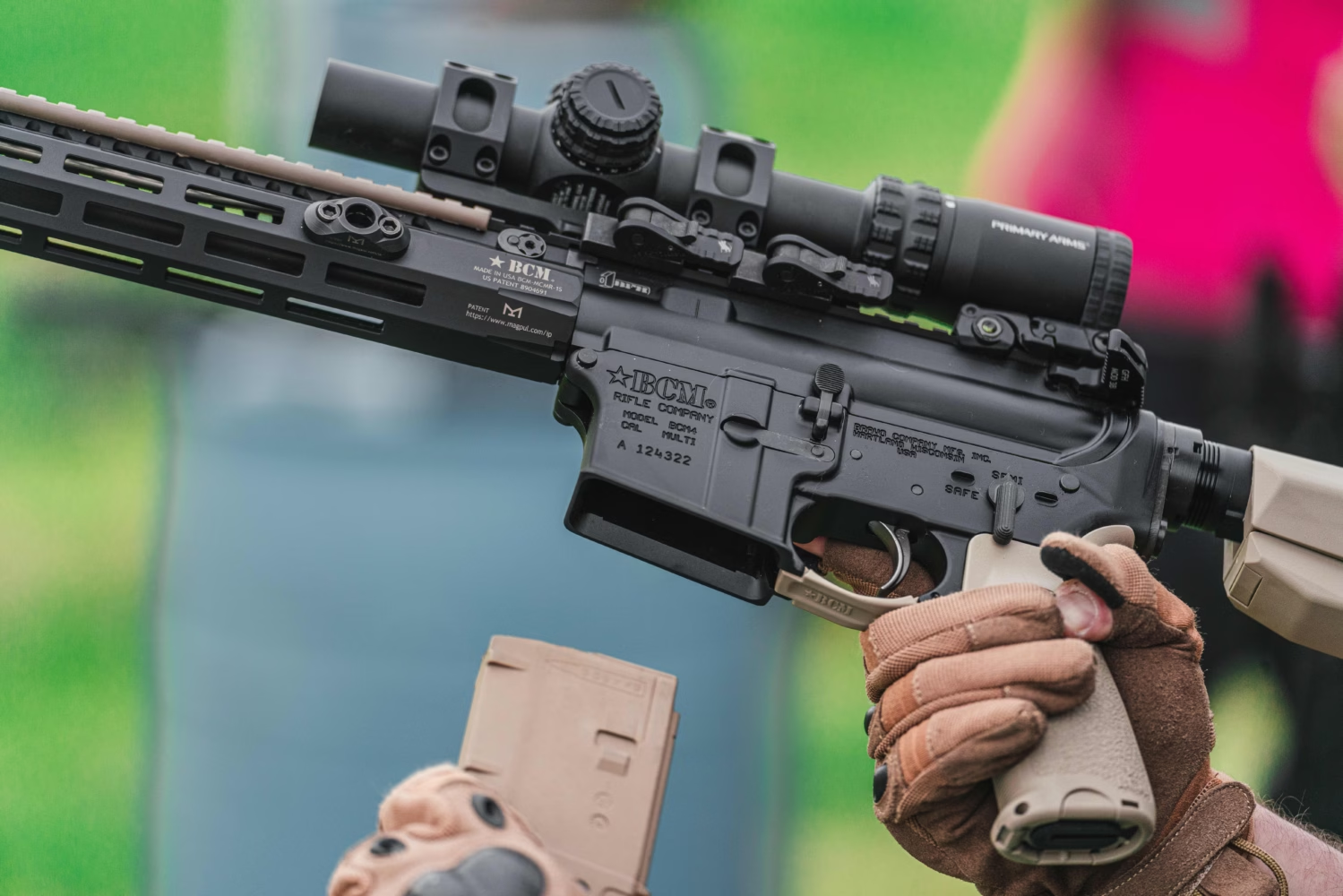
Conclusion
A well-appointed AR-15 is a great first step toward setting up your 3-Gun competition kit. By tuning your rifle to minimize recoil, limit weight, and optimize accuracy and speed, you can set yourself up for success and shave seconds off your stage times.

